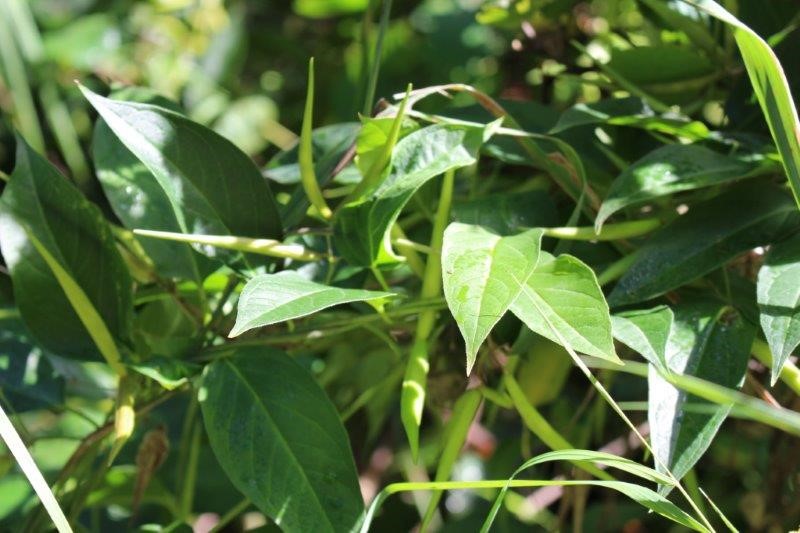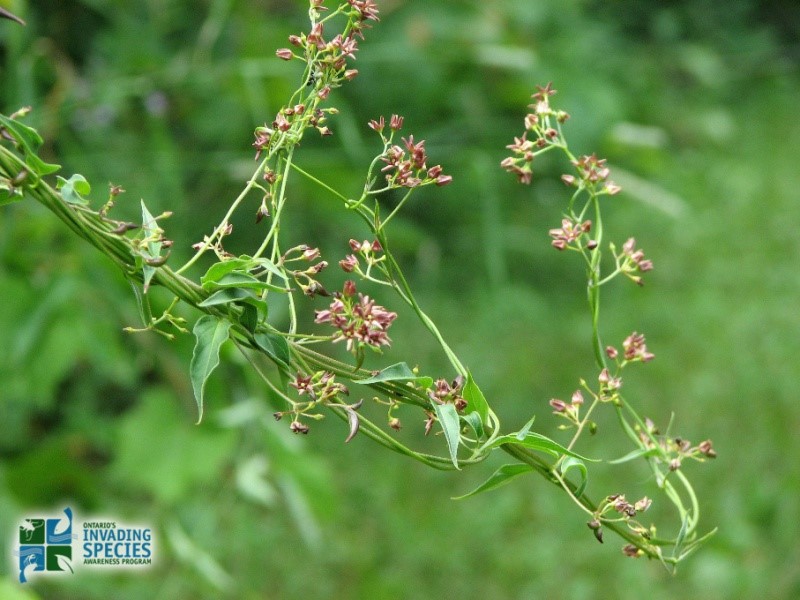Table of Contents
Invasive Species

Dog-strangling Vine, showing seed pods and oval leaves with pointed tips. Photo: Derek Lavallee
2.3 Dog-strangling Vine
Name: Dog-strangling Vine (Vincetoxicum rossicum)
General Information: Dog-strangling Vine is a perennial herbaceous plant in the milkweed family (Asclepiadaceae) that is native to southern Europe. It can spread rapidly and form thick mats of vegetation that outcompete native plants for sunlight, water, and nutrients. It can grow aggressively and climb up to 2 meters in height by wrapping (twining) around trees and vertical structures. There is evidence that Dog-strangling Vine is allelopathic, meaning that it produces chemicals that inhibit the growth of nearby plants. Deer and other browsing animals avoid eating Dog-strangling Vine, which may then increase browsing pressure on native plant species. Monarch Butterflies can also be affected because they may mistakenly lay eggs on Dog-strangling Vine, where the larvae will not survive, instead of on native milkweed species which is their intended host plant.
Dog-strangling Vine can grow in a wide range of habitats; it prefers sunny conditions but also grows well in partial shade. It can typically be found growing along roadsides, fence lines, utility corridors, and stream banks. It can even invade closed-canopy forests where it may become the dominant ground cover, and inhibit forest regeneration. Dog-strangling Vine can grow to be so dense that it becomes difficult to walk through and can also interfere with other recreational activities. Seeds of the Dog-strangling Vine can be spread short distances by wind, or long distances by humans, animals or vehicles on which they have become attached.
Identification: Leaves are opposite, smooth, green, oval with a pointed tip, and approximately 7-12 cm long and 5-7 cm wide. The stems can have fine hairs present, and characteristically climb available structures or twine around themselves. Plants with stems twined around themselves can form dense mats of vegetation. Pink to rusty-red coloured flowers with 5 petals each are produced in early summer, with 5-20 flowers in a cluster produced at the leaf axils. In late summer long, slender fruit pods form that are approximately 4-7 cm long and 0.5 cm wide. The pods exude a milky sap when broken, and turn from green to light brown as they age. Similar to other species in the milkweed family, mature seeds are attached to tufts of feathery hair that aid in distribution on the wind. Although there are some similarities in appearances between Dog-strangling Vine and other milkweed species (e.g. Swamp Milkweed, Asclepias incarnata), only Dog-strangling Vine twines (coils around something) as it grows.
Control: Dog-strangling Vine is a persistent invasive species and initial efforts should be focussed on limiting the spread of established populations and eliminating satellite populations. Simple approaches may include picking fruit pods from the plant before they mature to limit natural seed dispersal, but more effective methods will require cutting/digging, and removing the plant material. Some plants may require herbicide treatment for successful eradication; contact Ontario Parks for further information.
Dog-strangling Vine is regulated as a restricted species under the Ontario Invasive Species Act, 2015 (https://www.ontario.ca/laws/statute/s15022). Under the act, a restricted species is prohibited from being brought into a provincial park, and prohibited from being deposited or released in Ontario.
Information sources:
Ontario’s Invading Species Awareness Program: Dog-strangling Vine
http://www.invadingspecies.com/invaders/plants-terrestrial/dog-strangling-vine/
Best Management Practices in Ontario: Dog-strangling Vine
http://www.ontarioinvasiveplants.ca/wp-content/uploads/2016/06/OIPC_BMP_DogStranglingVine.pdf

Dog-strangling Vine, showing pink star-shaped flowers and the twining character of the stems. Source: Ontario’s Invading Species Awareness Program, Photo: Ken Towle